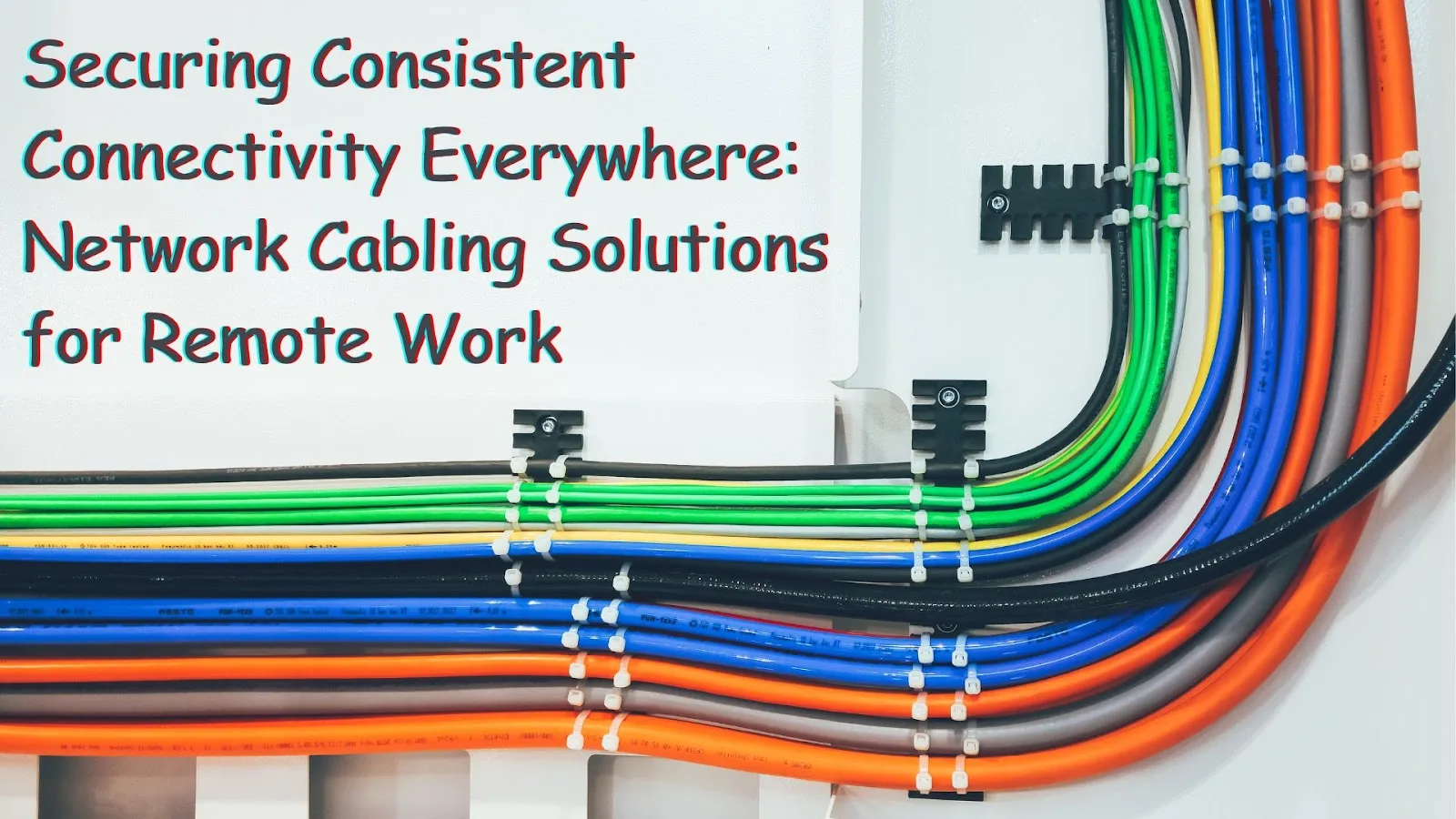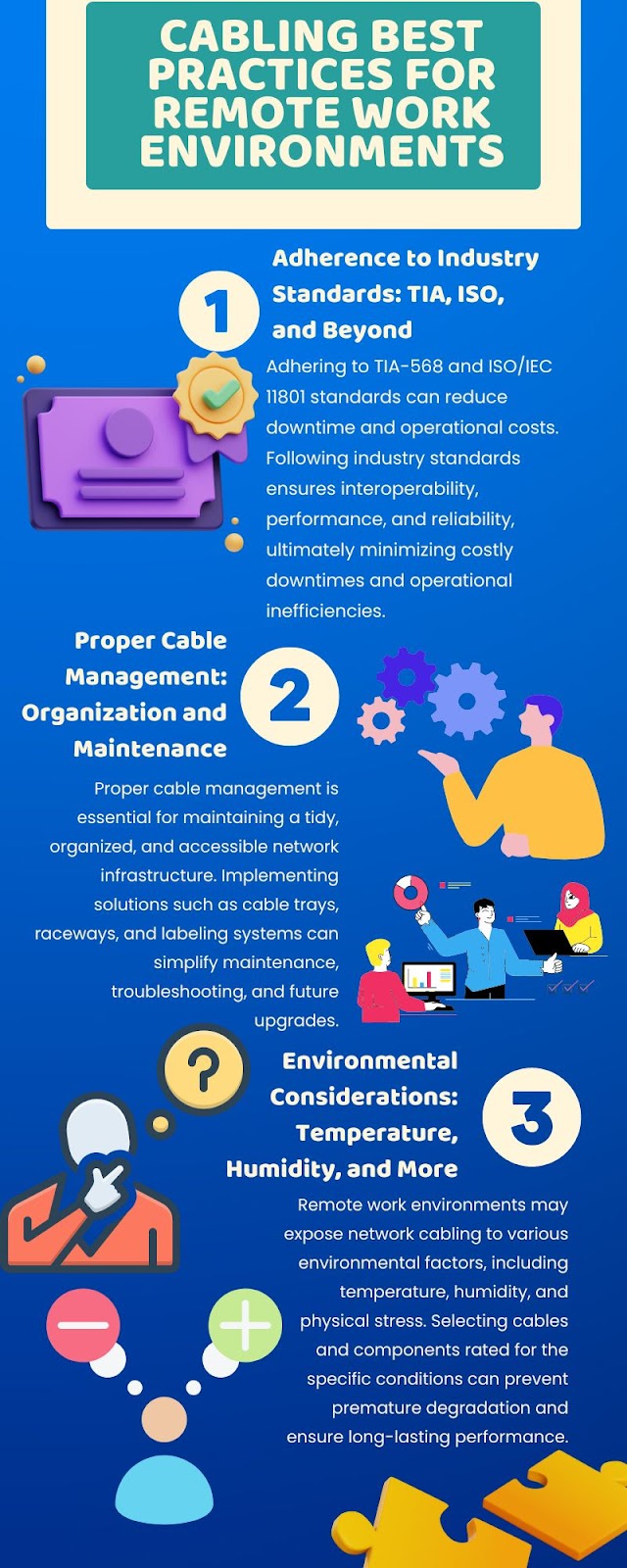
Securing Consistent Connectivity Everywhere: Network Cabling Solutions for Remote Work
In today’s digital age, where remote work has become the norm, ensuring seamless connectivity is paramount for businesses to thrive. As organizations embrace distributed workforces, the need for robust network cabling solutions has never been more critical. This comprehensive guide delves into the heart of the matter, exploring how strategic cabling infrastructure can empower remote teams with consistent, secure, and future-proof connectivity.
-
Cable Infrastructure: The Backbone of Seamless Remote Connectivity
The global structured cabling market is projected to reach $21.48 billion by 2029, growing at a CAGR of 9.2%. This staggering growth highlights the increasing importance of network cabling infrastructure in enabling seamless remote work connectivity.
-
Copper vs. Fiber Optic: Weighing Pros and Cons
Copper and fiber optic cables each offer unique advantages and trade-offs. While copper cables are cost-effective and suitable for shorter distances, fiber optic cables boast higher bandwidth, longer reach, and immunity to electromagnetic interference (EMI). The choice between the two depends on factors such as distance, bandwidth requirements, and budget constraints.
-
Structured Cabling Systems: A Unified Approach
A structured cabling system provides a standardized, comprehensive approach to network infrastructure design, encompassing cables, connectors, and pathways. By following a structured approach, organizations can ensure scalability, manageability, and seamless integration of various communication technologies.
-
Scalability and Future-Proofing: Accommodate Growth
As remote work continues to evolve, cabling solutions must be designed with scalability in mind. By implementing a modular, forward-thinking infrastructure, businesses can seamlessly accommodate future growth, emerging technologies, and changing connectivity demands.
II. Overcoming Network Cabling Challenges for Remote Workforces
As the structured cabling market continues its rapid growth, projected to reach $21.48 billion by 2029, overcoming network cabling challenges has become crucial for enabling seamless remote work connectivity.
-
Distance Limitations: Extending Reach with Advanced Solutions
Distance can be a significant hurdle in remote work environments, as signal degradation increases over longer cable runs. Advanced solutions, such as fiber optic cabling, network extenders, and Power over Ethernet (PoE) technologies, can help extend the reach of network connectivity without compromising performance.
-
Electromagnetic Interference: Shielding for Optimal Performance
Electromagnetic interference (EMI) can wreak havoc on network performance, causing data corruption and connectivity issues. Shielded cabling, proper grounding, and cable management practices are essential to mitigate the effects of EMI and ensure optimal signal integrity.
-
Physical Security: Safeguarding Data Integrity
In remote work scenarios, physical security becomes a critical concern. Implementing measures such as secure cable pathways, access control, and tamper-evident solutions can help safeguard sensitive data and prevent unauthorized access to network infrastructure.
III. Cabling Best Practices for Remote Work Environments
Some network performance issues stemming from cabling infrastructure problems, adhering to best practices in cabling for remote work environments is imperative.

IV. Integrating Network Cabling with Remote Work Technologies
By following industry standards like TIA-568 and ISO/IEC 11801, which can reduce downtime and operational costs, organizations can seamlessly integrate their network cabling with essential remote work technologies.
-
Unified Communications: VoIP, Video Conferencing, and Collaboration Tools
Robust cabling solutions are essential for supporting high-quality Voice over IP (VoIP), video conferencing, and real-time collaboration tools that enable effective remote teamwork.
-
Computing and Virtual Desktop Infrastructure (VDI)
As remote work drives the adoption of cloud computing and Virtual Desktop Infrastructure (VDI), network cabling plays a pivotal role in ensuring low-latency, high-bandwidth connectivity for seamless access to cloud-based resources and virtual desktops.
-
Internet of Things (IoT) and Smart Building Integration
The integration of Internet of Things (IoT) devices and smart building systems can enhance remote work efficiency and productivity. A robust cabling infrastructure is crucial for supporting IoT connectivity, enabling remote monitoring, automation, and intelligent building management.
Comparison of popular cable types for remote work connectivity solutions
|
Cable Type |
Maximum Cable Segment |
Speed |
Bandwidth |
Distance |
|
Fiber Optic Cable |
2km-10km |
Up to 800 Gbps |
Hundreds of GHz |
Up to 80km |
|
Twisted Pair Cable |
100m |
Up to 10 Gbps |
Cat5: 100MHz Cat5e: 100-250MHz Cat6: 250-500MHz Cat6a: 500-1000MHz |
Up to 100m |
|
Coaxial Cable |
200-500m |
10Mbps-100Mbps |
RG6: 1-2.3GHz RG11: 1-3GHz |
Up to 500m |
V. Assessing Return on Investment (ROI) for Network Cabling Solutions
Assessing the return on investment for robust network cabling solutions is crucial.
-
Cost-Benefit Analysis: Initial Investment vs. Long-Term Savings
While the upfront costs of implementing a robust cabling infrastructure may seem substantial, it’s essential to consider the long-term savings and benefits. A well-designed cabling system can minimize downtime, reduce maintenance costs, and future-proof your network for years to come.
-
Productivity Gains: Seamless Connectivity’s Impact on Workflow
Consistent, reliable connectivity is a cornerstone of productive remote work. By investing in network cabling solutions, organizations can minimize frustrating connectivity issues, enabling remote teams to collaborate effectively and maintain uninterrupted workflow.
-
Competitive Advantage: Enabling Agility and Resilience
This long-term value proposition underscores the competitive advantage of a robust cabling infrastructure, enabling organizations to be agile, resilient, and adaptable in the face of evolving business demands and remote work trends.
Conclusion
In the era of remote work, robust network cabling solutions are the backbone of consistent connectivity, enabling organizations to thrive in a distributed workforce landscape. By investing in strategic cabling infrastructure, businesses can overcome distance limitations, mitigate electromagnetic interference, and safeguard data integrity. Adhering to industry best practices and standards not only enhances performance but also seamlessly integrates essential remote work technologies, such as unified communications, cloud computing, and IoT devices.
The return on investment for network cabling solutions is undeniable, with long-term savings, productivity gains, and a competitive edge in agility and resilience. As the demand for remote work continues to surge, businesses that prioritize cabling infrastructure will be well-positioned to secure consistent connectivity everywhere, empowering their remote teams to collaborate effectively and drive success in the digital age.
Frequently Asked Questions
-
How do network cabling solutions enhance security and data protection for remote workers?
Network cabling solutions can enhance security and data protection for remote workers in several ways: Shielded cables and proper grounding mitigate electromagnetic interference (EMI), reducing the risk of data corruption or interception; Physical security measures, such as secure cable pathways and access control, prevent unauthorized access to network infrastructure and sensitive data; Adherence to industry standards ensures end-to-end encryption and secure communication protocols, protecting data in transit; Robust cabling solutions enable seamless integration of virtual private networks (VPNs) and other security solutions for remote access.
-
What are the common pitfalls to avoid when implementing network cabling solutions for remote work environments?
Some common pitfalls to avoid include: Underestimating bandwidth requirements and failing to future-proof the infrastructure; Neglecting proper cable management, leading to disorganization and maintenance nightmares;Overlooking environmental factors like temperature, humidity, and physical stress; Failing to adhere to industry standards, resulting in interoperability issues and suboptimal performance; Overlooking physical security measures, leaving the network vulnerable to unauthorized access.
-
Can existing cabling infrastructure be retrofitted for remote work needs, or is a complete overhaul necessary?
In some cases, existing cabling infrastructure can be retrofitted to accommodate remote work needs, depending on factors such as: Age and condition of the existing cables and components; Adherence to current industry standards and performance requirements; Scalability and capacity to handle increased bandwidth demands; Physical layout and accessibility for upgrades and maintenance.
Source: ArticleCube


